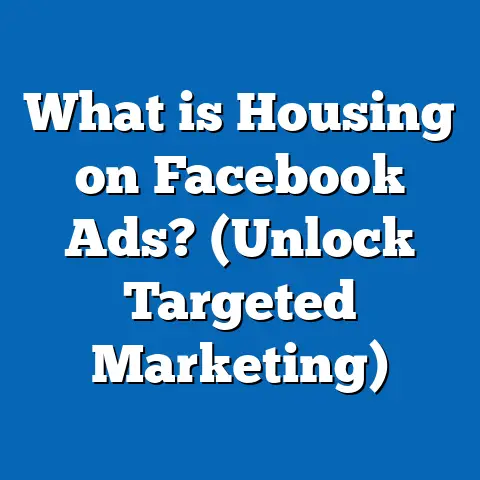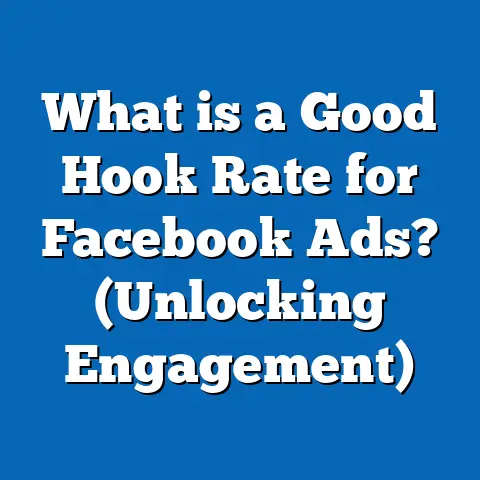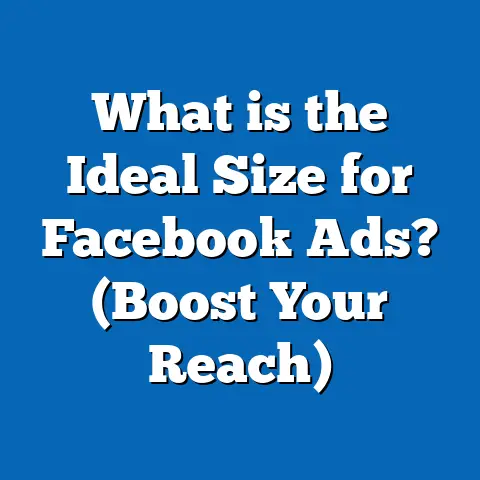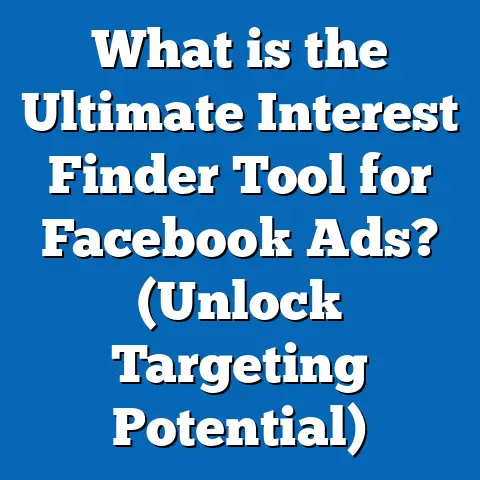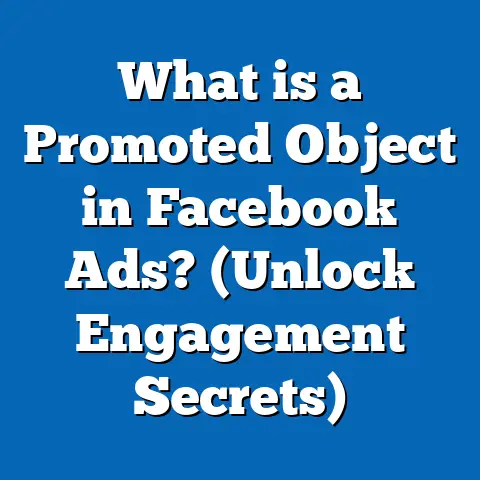What is Negative Feedback on Facebook Ads? (Impact on ROI)
What is Negative Feedback on Facebook Ads? (Impact on ROI)
Introduction: Tying Facebook Ads to Your Hobbies and Passions
Imagine you’re passionate about gardening. You love spending your weekends planting flowers, trimming hedges, and learning about the best fertilizers. Now picture scrolling through Facebook, hoping to find content that fits your hobby—tips on pruning roses or recommendations for organic soil. But instead, you’re bombarded with ads for unrelated products like gaming apps or fast food. Annoying, right?
That irritation is exactly the kind of experience that negative feedback on Facebook ads captures. When users consistently see ads that don’t match their interests or feel intrusive, they respond negatively. These reactions influence how Facebook delivers ads and can have a big impact on your advertising results and return on investment (ROI).
For marketers and business owners, understanding negative feedback is crucial. It’s not just about avoiding annoyances for users—it’s about optimizing ad performance, cutting costs, and improving the connection between your brand and your audience.
In this article, we will explore what negative feedback really means on Facebook ads, why it matters, how it affects your ROI, and most importantly, how you can manage and reduce it for better campaign results.
Understanding Negative Feedback on Facebook Ads
What is Negative Feedback?
Negative feedback is any action a Facebook user takes indicating they do not want to see a particular ad or find it inappropriate or annoying. Unlike positive engagement such as clicks, likes, or shares, negative feedback signals dissatisfaction. This feedback includes:
- Hide Ad: Users click “Hide ad” to stop seeing the specific ad.
- Hide All Ads From Advertiser: Users decide they want to block all ads from a particular advertiser.
- Report Ad: Users report the ad as spam, misleading, offensive, or inappropriate.
- Block Page: Users block the advertiser’s Facebook Page.
- Skip Video Ad: Users skip video ads quickly or repeatedly.
Each of these actions tells Facebook’s algorithm that the ad is not relevant or welcomed by the audience.
Why Does Negative Feedback Matter?
Facebook’s advertising platform is designed to deliver ads that users find relevant and engaging. Its goal is to keep users happy so they continue spending time on the platform. When users give negative feedback, Facebook reduces the distribution of those ads to protect the user experience.
From an advertiser’s perspective, this means:
- Ad Delivery Drops: Facebook limits how often and how widely your ad is shown.
- Costs Rise: Ads with high negative feedback tend to cost more per click or conversion.
- ROI Falls: Reduced delivery and higher costs mean fewer results for your budget.
- Brand Perception Suffers: Negative user experiences can damage brand reputation over time.
Thus, negative feedback is not just a user annoyance metric—it directly affects your bottom line.
The Impact of Negative Feedback on ROI
How Negative Feedback Affects Campaign Performance
Let’s break down the core ways negative feedback impacts your advertising ROI:
1. Lower Ad Relevance Score
Facebook assigns each ad a relevance score ranging from 1 to 10 based on user reactions and engagement. High negative feedback lowers this score.
A low relevance score signals to Facebook that users don’t find your ad valuable. As a result:
- Facebook shows your ad less often.
- Your ad loses priority in the auction.
- Cost per click (CPC) and cost per acquisition (CPA) increase.
2. Increased Costs Per Result
Studies show that ads with poor user reception tend to cost more because Facebook must compensate for the bad experience by charging higher bid prices.
Data Insight:
- WordStream found that ads with relevance scores below 5 can see CPC increase by up to 30%.
- Facebook’s internal benchmarks suggest campaigns experiencing over 5% negative feedback can see CPC increases of 20% or more within days.
3. Reduced Audience Reach and Delivery
Facebook’s algorithm penalizes ads that generate frequent negative feedback by reducing their delivery volume. This restricts your ad from reaching new potential customers.
In practice, this means:
- Your targeted audience sees your ads less often.
- Your campaign momentum stalls.
- You need larger budgets to maintain similar reach.
4. Damaged Brand Image
Repeatedly annoying or irrelevant ads may cause users to associate your brand with negative experiences. This can lead to:
- Reduced organic engagement with your page.
- Loss of repeat customers.
- Negative word-of-mouth impacting future marketing efforts.
Data-Backed Insights: Quantifying the Impact
To understand the scale of this issue, here are some key statistics from industry research:
| Metric | Statistic | Source |
|---|---|---|
| Average Hide Rate | ~0.5% considered normal | Facebook benchmarks |
| Conversion Drop | 15% decrease with 5% increase in negative feedback | AdEspresso study |
| CPC Increase | Up to 30% when relevance score <5 | WordStream |
| Reach Reduction | 25% drop in reach with >10% negative feedback | Facebook internal data |
| Report Rate Warning Level | >0.1% signals serious issues | Industry best practices |
These numbers highlight how even small increases in negative feedback can cause significant performance degradation.
Causes of Negative Feedback on Facebook Ads
Understanding why users provide negative feedback allows advertisers to address root causes proactively.
Common Reasons for Negative Feedback
- Irrelevant Targeting
If ads are shown to people outside their interest or demographic group, they are more likely to be hidden or reported.
For example, showing sports equipment ads to users who are not interested in sports will trigger negative responses.
- High Frequency
Seeing the same ad repeatedly can annoy users. This “ad fatigue” makes users hide or block ads more often.
Facebook recommends keeping frequency below 3 impressions per user per week for most campaigns.
- Poor Creative Quality
Low-resolution images, confusing copy, or boring videos reduce engagement and increase negative feedback.
- Misleading or Clickbait Content
When ads promise something different than what users get after clicking (e.g., “Free iPhone” but it’s a paid offer), users feel tricked and report the ad.
- Intrusive or Disruptive Formats
Auto-play videos with loud sound or pop-up ads can annoy users and lead to hiding/blocking.
Practical Example: Targeting Mistakes in a Hobby Niche
A company selling high-end fishing gear launched a campaign targeting “outdoor enthusiasts” broadly without narrowing down interests specifically related to fishing. Many users interested only in hiking or camping saw the ads and found them irrelevant. The campaign experienced a high hide rate of 1.3%, causing CPC to rise by 25%. After refining targeting to “fishing enthusiasts,” hide rate dropped to 0.4%, reducing CPC by 18%.
How Facebook Measures and Reports Negative Feedback
Metrics Related to Negative Feedback in Ads Manager
Facebook provides advertisers with detailed metrics that track negative feedback:
| Metric | Description |
|---|---|
| Hide Rate | Percentage of impressions where users clicked “Hide Ad” |
| Hide All Ads Rate | Users hiding all ads from your page |
| Report Rate | Percentage reporting the ad as spam/inappropriate |
| Block Rate | Users blocking your page from appearing |
These metrics are crucial for diagnosing issues early.
Accessing Negative Feedback Metrics
- Go to Facebook Ads Manager.
- Customize columns in report settings.
- Add columns like “Negative Feedback,” “Hide Rate,” and “Report Rate.”
- Analyze trends over time and across campaigns/ad sets.
Benchmarking Your Negative Feedback Rates
Industry standards provide rough guidelines:
- Hide Rate below 0.5% — Normal
- Hide Rate between 0.5%–1% — Needs attention
- Hide Rate above 1% — High risk of performance decline
Report rates should ideally be under 0.1%.
Reducing Negative Feedback: Best Practices
1. Refine Audience Targeting
Use Facebook’s advanced targeting tools like Detailed Targeting, Custom Audiences, and Lookalike Audiences for precision.
Tips:
- Use interest-based targeting aligned closely with product benefits.
- Exclude irrelevant demographics.
- Use retargeting for warm leads rather than broad cold audiences.
2. Control Ad Frequency
Set frequency caps within campaign settings or optimize budgets and scheduling to avoid overexposure.
Example: For brand awareness campaigns, keep frequency below 2–3 impressions per week per user.
3. Improve Ad Creative Quality
High-quality images/videos with clear messaging reduce negative feedback.
Creative Checklist:
- Use high-resolution visuals.
- Keep text concise and relevant.
- Use compelling CTAs.
- Avoid overly promotional language.
4. Honest and Transparent Messaging
Avoid clickbait headlines or misleading offers which frustrate users post-click.
5. Test Multiple Variations (A/B Testing)
Run A/B tests on creative elements like headlines, images, offers, and calls-to-action (CTAs) to identify combinations with lower negative feedback.
6. Monitor Feedback Regularly
Set alerts for spikes in hide/report rates and pause or adjust ads promptly.
Case Studies: Negative Feedback Impact and Recovery
Case Study 1: E-commerce Fashion Brand
Situation:
An online fashion retailer ran a holiday sale campaign targeting broad “women aged 25–45” audiences with static image ads repeated daily for two weeks.
Problem:
The campaign experienced a hide rate of 1.2%, causing CPC to rise 35%, conversions to drop by 20%, and overall ROI decline of 40%.
Solution:
- Narrowed targeting using lookalike audiences based on previous customers.
- Introduced new creatives every two weeks.
- Lowered frequency by spreading budget over a longer period.
Result:
Hide rate dropped to 0.4%, CPC decreased by 22%, conversion rate improved by 15%, leading to a 35% ROI increase over the next campaign cycle.
Case Study 2: Mobile Gaming App Launch
Situation:
A mobile gaming company launched an app campaign using aggressive retargeting video ads auto-playing with sound at high frequency targeting broad interests like “mobile games.”
Problem:
High report rate (0.15%) and block rate led to sharp delivery drops and rising CPA ($15).
Solution:
- Changed video ads to muted autoplay and static images.
- Reduced retargeting frequency limits.
- Refined audience segments to hardcore gamers only.
Result:
Negative feedback dropped by 60%, CPA reduced to $9, and installs increased by 25%.
Comparing Facebook’s Negative Feedback System with Other Platforms
| Platform | Negative Feedback Mechanisms | Impact on Advertising |
|---|---|---|
| Hide Ad, Report Spam/Inappropriate, Block Page | Reduced delivery, higher CPC/CPA when negative feedback rises | |
| Same as Facebook (shared platform) | Similar penalties; critical for visual campaigns | |
| Google Ads | Disapprovals for policy violations; user complaints | Ads disapproved/limited; no direct user hide/report options |
| Twitter Ads | Unfollow advertiser’s account; mute tweets; report | Lower engagement; reduced impressions; account suspension risk |
Facebook’s detailed negative feedback system offers advertisers granular insights but also enforces stricter quality control compared to many other platforms.
Advanced Strategies for Managing Negative Feedback
Leverage Audience Insights for Precise Targeting
Use Audience Insights tool to analyze demographics, behaviors, and interests of people who engage positively with your page or website visitors.
This data helps tailor audiences who are more likely to respond positively to your ads.
Dynamic Creative Optimization (DCO)
Use Facebook’s DCO feature which automatically tests multiple creative elements (images, headlines, CTAs) to identify combinations that resonate best and reduce negative reactions.
Real-Time Monitoring & Rapid Response
Set automated notifications for sudden spikes in hide/report rates via third-party tools or Facebook’s built-in alerts.
Quickly pause or modify problematic ads before they do major damage.
Utilize Video Completion Rates as Early Indicators
Low video completion rates often correlate with increased negative feedback for video ads; optimize video length/content accordingly.
Practical Tips for Business Owners and Marketers
- Always include negative feedback metrics in your campaign KPIs alongside CTRs and conversions.
- View negative feedback as actionable data rather than just bad news—it guides campaign improvement.
- Prioritize relevance over reach; highly targeted smaller audiences often yield better ROI than broad untargeted ones.
- Educate your marketing team about the impact of frequency and creative fatigue.
- Plan creative refresh cycles proactively — rotate new creatives every 1–2 weeks.
- Use customer feedback from other channels (surveys, reviews) to inform ad messaging alignment.
Emerging Trends & Future Outlook in Facebook Advertising Feedback
AI-Powered Personalization Increasing Expectations
Facebook’s machine learning algorithms increasingly personalize ad delivery based on micro-behaviors. This means even minor irrelevant ads can trigger negative feedback faster than before.
Stricter Policies & Automated Moderation
Facebook continues updating its ad policies and automated moderation systems that penalize ads generating reports rapidly—advertisers must stay compliant and vigilant.
Cross-Platform User Behavior Tracking
With Meta’s ecosystem integration (Facebook + Instagram + WhatsApp), user behavior signals affecting negative feedback now have broader implications across platforms for better or worse.
Summary and Key Takeaways
What You Need to Know About Negative Feedback on Facebook Ads
- Negative feedback consists of user actions like hiding ads, reporting spam/inappropriate content, blocking pages, or skipping videos.
- High levels of negative feedback drastically reduce ad effectiveness by lowering relevance scores, increasing CPC/CPA, limiting delivery reach, and damaging brand reputation.
- Causes include irrelevant targeting, excessive frequency, poor creative quality, misleading messaging, and intrusive formats.
- Monitoring Hide Rate, Report Rate, Block Rate metrics regularly is essential for early detection of issues.
- Refining audience targeting, managing frequency carefully, improving creative quality, ensuring honest messaging, and conducting A/B testing reduce negative responses.
- Real-world case studies show how addressing negative feedback leads to significant improvements in ROI.
- Compared with other platforms like Google Ads or Twitter Ads, Facebook offers more granular user-driven feedback signals but also enforces stricter penalties on poor-performing ads.
- Advanced strategies like dynamic creative optimization and real-time alert systems help maintain healthy campaigns in today’s competitive landscape.
Next Steps for Marketers & Business Owners:
- Audit current campaigns’ negative feedback metrics via Ads Manager.
- Segment audiences more precisely using Facebook’s tools.
- Refresh creatives regularly while avoiding repetition fatigue.
- Implement A/B testing focused on reducing negative reactions.
- Set up real-time alerts for spikes in hide/report rates.
- Continuously analyze performance data and adjust strategies accordingly.
- Stay updated on Facebook’s evolving ad policies and platform changes.
By mastering the management of negative feedback on Facebook ads, marketers can safeguard advertising budgets while maximizing campaign impact—turning potential pitfalls into powerful growth opportunities.
If you need detailed templates for monitoring negative feedback metrics or custom checklists for creative reviews tailored by industry type/hobby niche (like photography/gardening/fitness), feel free to ask!

